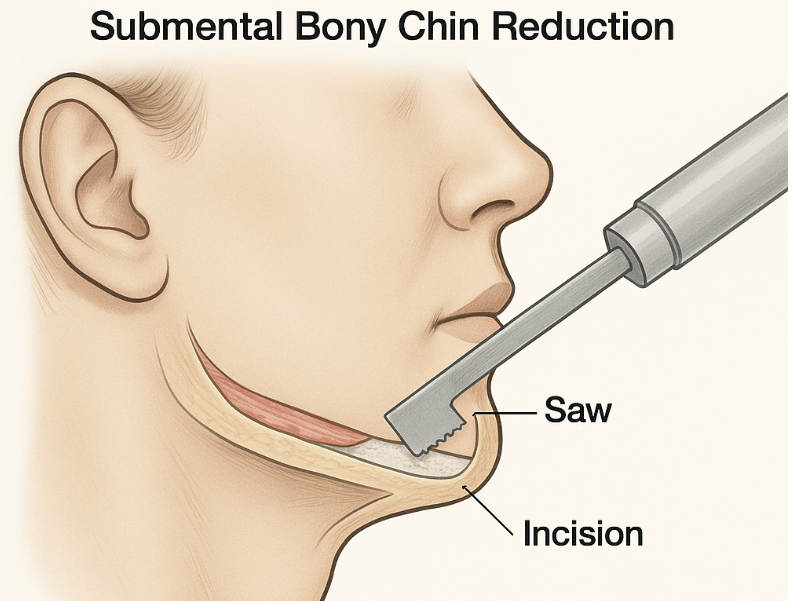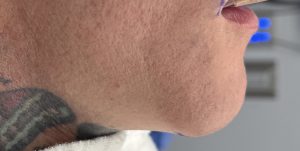Introduction
Bony chin reduction, when performed by shaving, can be done from two different approaches, either from above (intraoral) or from below (submental). While both approaches provide access to the chin bone the dimensional reductions that can be achieved between ram are different.
The submental approach provides direct, wide exposure of the lower chin bone which is favorable when:
- The patient has excess vertical chin height
- The chin needs central narrowing or contouring
- The patient already needs a submental incision for another procedure (e.g., submentoplasty, neck lift)
- The goal is precise sculpting of the lower mandibular border
- There is significant bone asymmetry better corrected with direct visualization
- Soft tissue reduction of the chin pad is needed (chin pad ptosis) or will result with the bony reduction.
- A prior intraoral bony reduction was done that was inadequate and/or resulted in excess soft tissue chin pad tissue.
It can make the following changes to the chin:
? Bony vertical height (shorter chin)
? Bony projection (less forward)
? Chin width (narrower)
? Lower mandibular border prominence
- ?Asymmetry Correction
- ?Soft tissue chin pad removal
Case Study
This patient has a prior intraoral chin reduction as part of an overall facial feminization surgery. They felt that no significant changes to the chin were seen. It was still too long, had too much forward projection and was still too wide.


Discussion
Which bony chin shaving approach is best depends on the patient’s anatomy and the type of bony change needed.
Incision Location & Scarring
Submental Approach
- Small incision hidden in the crease under the chin
- Leaves a small external scar (usually faint, but visible on close examination)
Intraoral Approach
- Incision inside the mouth
- No visible external scar
? If avoiding any external scar is a priority ? intraoral is preferred.
? If precision is more important than scar invisibility ? submental approach is best.
Surgical Exposure & Precision
Submental
- Direct, wide-open exposure of the entire lower border and chin point
- Allows much more precise contouring, especially for:
- vertical height reduction
- asymmetry correction
- smoothing irregularities
- narrowing the chin
- Easier to see and feel the bone as it’s sculpted
- Lower risk of injuring the mental nerves (they are more easily avoided)
Intraoral
- Limited exposure because the surgeon works through a small tunnel
- Harder to visualize the lower border directly
- More challenging for:
- asymmetry correction
- sculpting irregularities
- central narrowing
- Mental nerves are closer to the surgical field, so care is required
? For precision bone sculpting ? submental is superior.
? For straightforward reduction ? intraoral works well.
Best Use Cases (Indications)
Submental Approach is ideal for:
- Large vertical chin reduction
- Smoothing an irregular lower mandibular border
- Central narrowing of a wide chin
- Correcting bony asymmetry
- Patients who already need a submental incision (neck lipo, cervicoplasty)
- Very strong or “heavy” chin pads that also need soft tissue thinning
Intraoral Approach is ideal for:
- Patients who want no external scar
- Smaller reductions in projection or height
- Cases where the lower border contour does not need reshaping
- When combined with sliding genioplasty (intraoral is standard)
Risks & Sensory Effects
Submental
- Slightly lower risk of mental nerve stretch/injury
- Possible faint scar
- Swelling is mostly under the chin, less inside the mouth
Intraoral
- Higher risk of temporary numbness inside the lower lip/chin
- No external scar
- More intraoral swelling and discomfort
? If nerve safety is a priority ? submental often wins.
? If scarlessness is more important ? intraoral.
Recovery Differences
Submental
- Faster than inside-mouth recovery
- Incision under the chin requires no special care
- Chin and neck swelling mainly external
Intraoral
- Mouth soreness for a week after the surgery
- Must avoid pulling on the lower lip and maintain oral hygiene
- More swelling inside the lower lip and chin area
Summary Table
|
Feature |
Submental |
Intraoral |
|
Scar |
Small external (well hidden) |
None |
|
Precision of bone sculpting |
Highest |
Moderate |
|
Nerve safety |
Slightly better |
More risk of stretch |
|
Best for |
Asymmetry, lower border contouring, large reductions |
Minor/standard reductions, no-scar preference |
|
Visualization |
Excellent |
Limited |
|
Combine with neck work |
Key Points
1) When an intraoral bony chin reduction is inadequate the siubmental approach offers improved results.
2) Secondary chin bone removal will always necessitate the need for soft tissue chin pad reduction.
3) Proper incisional placement in a submental skin crease if present dictates how the soft tissue chin pad reduction is done.
Barry Eppley, MD, DMD
World-Renowned Plastic Surgeon





